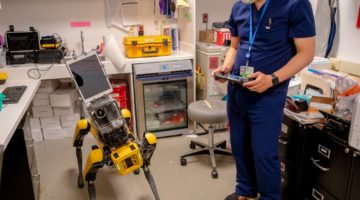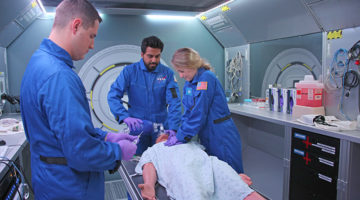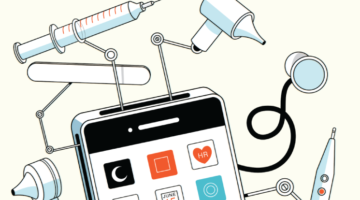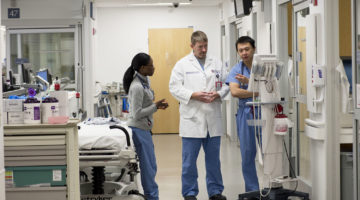
Bharti Khurana, MD, is the inaugural recipient of a Stepping Strong Innovator Award in injury prevention. In this interview, Khurana talks with Donna Woonteiler about her winning project—Making the Invisible Visible: Bringing Intimate Partner Violence (IPV) into Focus—and reflects on the rise of domestic violence during the COVID pandemic.
What exactly is Intimate Partner Violence, and how are you addressing it in your Stepping Strong Innovator Award project?
IPV a serious and widely prevalent public health crisis that is defined as physical, sexual, or emotional violence between partners. The medical community can do much more to detect IPV and prevent its perpetuation, and that is what my team is hoping to achieve.
How common is IPV?
The severity and prevalence of IPV is of great concern. One in four women and one in seven men have reported experiencing severe physical violence from an intimate partner in their lifetime in the United States. Each year more than half of female homicides are linked to IPV. We also know that childhood exposure to IPV can lead to adverse mental and physical health effects in adults.
Where does IPV occur and how does it get diagnosed?
It is no secret that IPV can lead to severe traumatic injuries. Despite the urgency of this problem, however, IPV continues to be profoundly underdiagnosed and under-reported. Understandably, IPV is a sensitive topic. Since it typically occurs within the confines of a victim’s home, evidence can be elusive. And the cases we do know about only represent the tip of the iceberg.
I understand that IPV is on the rise during the COVID pandemic. Can you explain?
Yes, that’s true. We recently published our results in Radiology that showed a higher incidence of physical IPV with more severe injuries. Unfortunately, we believe that case numbers are underreported, as victims were fearful of contracting COVID in a hospital or shelter.
Several other factors have contributed to this challenge. For instance, lack of alternative housing options, limited child care, an increase of alcohol consumption during COVID, and IPV screenings are not administered during telemedicine appointments. Health care providers may miss cues, such as bruises and marks over the body, during virtual appointments.
While our frontline physicians are focused on COVID, this is an opportune moment for radiologists to take an active role in identifying IPV victims and allowing timely intervention. As we are expecting a second wave of the virus in the near future, it would be extremely useful to validate and implement our algorithm as soon as possible to proactively identify patients at risk and enable care of these victims during future lockdowns.
Tell us more about your algorithm and what you hope to achieve with the Stepping Strong funding.
My team is developing two sets of tools to address IPV. The first one uses machine learning to identify patients who are experiencing IPV, and the second one educates social workers and clinicians on best practices for approaching patients.
To identify patients, we are using artificial intelligence to teach a computer program to recognize the signs of IPV. Our goal with this work is to develop an integrated system that first analyzes historical imaging and clinical data, and then automatically alerts clinicians if a patient’s traumatic injuries have a probability for IPV.
As far as approaching patients, the first step is recognizing that many IPV patients think they are alone and may not want to share their stories. To address this, our multidisciplinary team is developing educational materials such as conversational guides that will facilitate open and meaningful dialogue.
We hope these tools and guides will empower patients and their families, strengthen the role of the medical community, and break the silence around IPV in our society.
Do you have any findings to share since receiving the Stepping Strong Innovator Award?
Yes! Shortly after receiving Stepping Strong funding—between January and April 2020—our team completed a radiological review of 688 known IPV victims. Along with defining common injury patterns for various body parts (face, arm, forearm, hand, foot, ankle, leg, and chest) we also specifically analyzed forearm and hand fractures to see their correlation with IPV and compared the radiologist’s prediction with patients’ self-disclosures.
We were thrilled to see the interest and enthusiasm among radiologists when we shared these findings for the first time at the Radiological Society of North America on Nov 30th, 2020. I am grateful to the society for recognizing the importance of this topic by allocating an entire featured session to IPV.
I am also excited to announce that several publications in the U.S. and Europe have highlighted our findings:
- New Study Shows Increase in Domestic Violence Injuries during COVID-19
Radiological Society of North America (RSNA) - Domestic violence rose during lockdown — and injuries are dramatically more severe, study finds
Los Angeles Times - Incidence and characteristics of spinal injuries in the victims of intimate partner violence
(IPV)Journal of Emergency Radiology - Intimate partner violence crisis in the COVID-19 pandemic: how can radiologists make a difference?
European Radiology - Intimate Partner Violence: A Primer for Radiologists to Make the “Invisible” Visible.
RadioGraphics. - Intimate Partner Violence: A Primer for Radiologists to Make the “Invisible” Visible
Video
Bharti Khurana, MD,is the founding director of the Trauma Imaging Research and Innovation Center at Brigham and Women’s Hospital. A passionate advocate for developing machine learning algorithms for injury detection, her clinical and research efforts involve imaging and interpretation of trauma, orthopaedic and spine trauma, intimate partner violence, whole body CT for trauma, MRI optimization in ED, and education and career building in the field of emergency radiology. She is also the course director for Emergency Radiology Harvard Medical School Continuing Medical Education program.
The Stepping Strong Innovator Awards program supports groundbreaking projects that address well-defined clinical problems in areas including bone, wound, and skin healing; limb transplant and reconstruction; bone and muscle regeneration; advanced stem cell technology; orthopaedic and plastic surgery; bioengineering, emergency preparedness and injury prevention.
This interview was originally published by The Gillian Reny Stepping Strong Center for Trauma Innovation.











